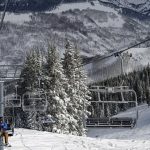Occupancy and revenue set all time records at Western U.S. mountain resorts during the 2015-16 winter season, surpassing the previous record set in the 2007-08 winter season, according to DestiMetrics.
As of April 30, actual occupancy at resorts monitored by the Denver research company was up 4.4 percent and revenues were up 5.2 percent compared to last season.1
“There was a considerable amount of dynamic tension between economic forces and weather conditions that really shaped the ebbs and flows of this season,” reported Ralf Garrison, director of DestiMetrics. “Good early season snow in many of the western mountain resorts and dramatically better snow conditions at Far West resorts, helped offset the undeniable slowdown in economic growth and collateral impacts of the strong US dollar and low oil prices. While final aggregated results were positive, there were significant fluctuations and more inconsistencies between resorts than we’ve seen in the past several years when consistent, double-digit growth was the norm.”
Momentum from both a record-breaking summer in 2015 and this past winter is continuing. As of April 30, bookings for the upcoming summer are pacing well ahead of last year with occupancy for arrivals from May through October up 11.6 percent and revenues up a dramatic 18.9 percent compared to the same time last year. Gains in both categories are being reported in all six summer and shoulder season months.
“Mountain summer business continues to outperform on all fronts, particularly in the late summer and fall months where growth has been noteworthy for several years,” observed Garrison.
The Briefing also reported that the robust economic growth of the past few years has slowed considerably in recent months. The Consumer Confidence Index dipped down 2.1 percent during April in a continuation of an erratic pattern that has persisted throughout the ski season and has included three increases and three decreases leaving the Index only 1.7 percent higher than it was at the start of the season. The Dow Jones Industrial Average stabilized in April after dramatic swings up and down during the previous three months but managed a slight 0.5 percent uptick from March’s closing. The National Unemployment Rate remained unchanged in April at five percent.
“Consumer and financial marketplaces are showing signs of strain as market crises in Asia and Europe along with a strong US dollar are combining to make it increasingly difficult to sustain the inbound flow of international goods and travelers,“ explained Tom Foley, director of operations for DestiMetrics. “The employment market has also showed a few cracks with a reduction in job creation but that didn’t have a negative impact on last ski season or appear to be affecting the upcoming summer,” he assured.
The Briefing also discussed the impact of the strengthening US dollar on last winter’s destination visitors. For inbound international visitors, the cost of their vacation rose an estimated 21 to 28 percent due to the currency exchange and served as a deterrent for some prospective visitors. At the same time, the strong dollar provided an attractive exchange rate for US residents and the opportunity to forsake US resorts this season in favor of a Canadian vacation available at a significantly reduced cost from recent years.
According to Foley, prospects for the coming summer are optimistic for a variety of reasons. A solid domestic economy, strong early bookings, and more broad-based and diverse activities from sporting events to festivals at mountain destinations are top reasons for continued growth and popularity. Resorts are also just starting to roll out the first wave of fresh on-mountain attractions made possible by the Ski Area Recreation Opportunity Enhancement Act that passed in 2014.
“Even though it is still relatively early days in the summer booking calendar, the momentum of the past four consecutive record-breaking summer seasons provides compelling evidence that mountain resorts are becoming more established as bonafide summer destinations with their ever expanding roster of events and activities,” confirms Garrison. “And with the strong advance bookings for the upcoming months that we’re already seeing, it is clear that summer vacationers have, in turn, fully embraced mountain destinations.”
1 DestiMetrics tracks resort performance in mountain destinations, compiling forward-looking reservation data on a monthly basis and aggregating and reporting the results to subscribers at participating resorts. Data for western resorts is derived from a sample of approximately 290 property management companies in 19 mountain destination communities, representing approximately 27,500 rooms across Colorado, Utah, California, Nevada, Oregon and Wyoming and may not reflect the entire mountain destination travel industry. Results may vary significantly among/between resorts and participating properties.












